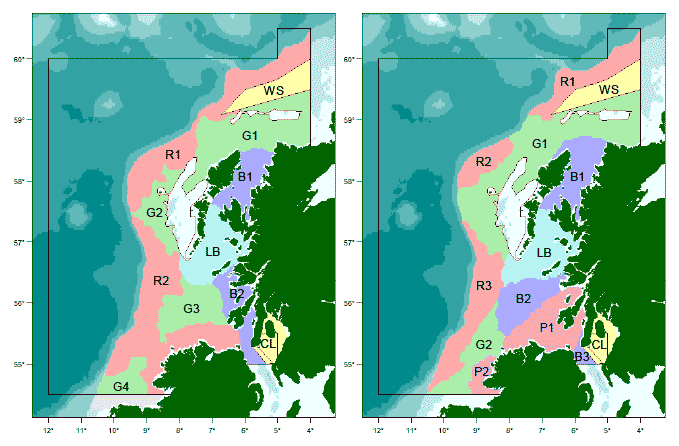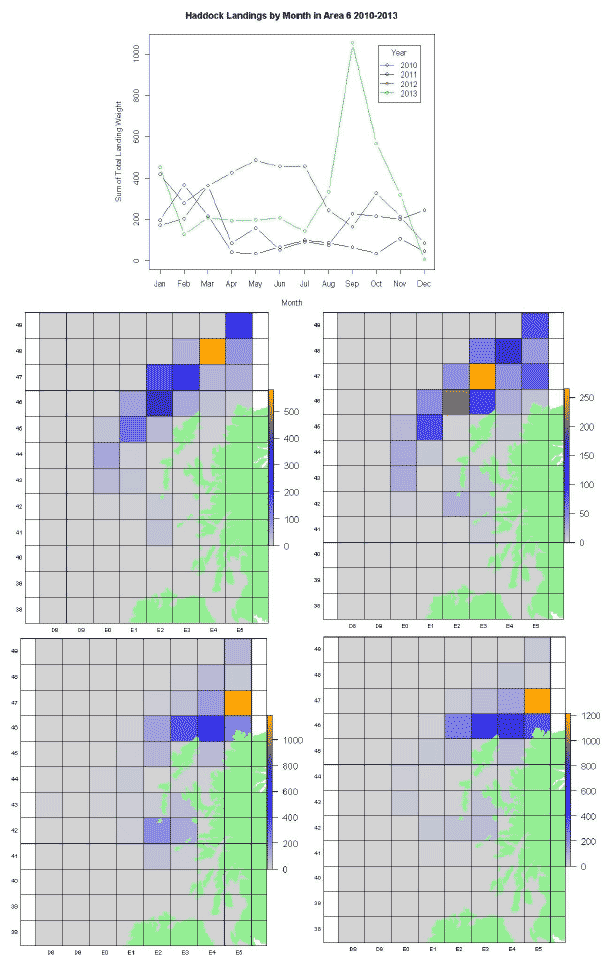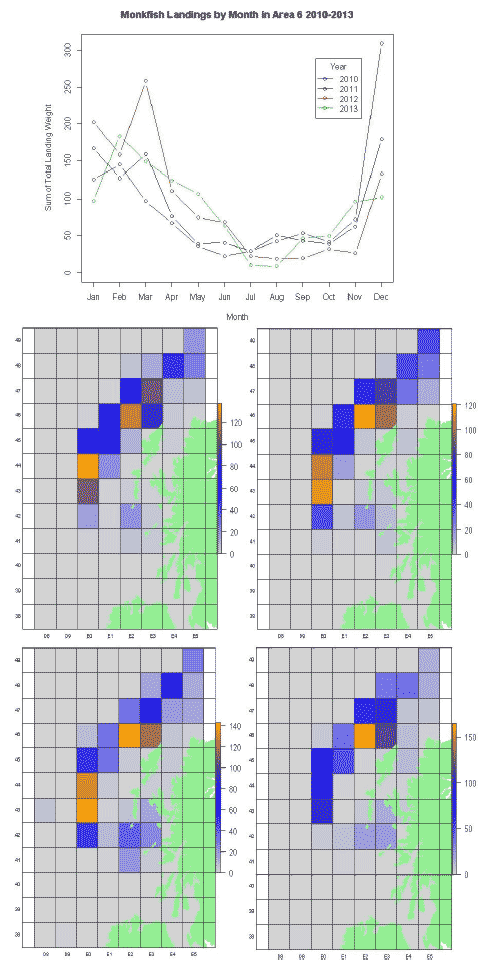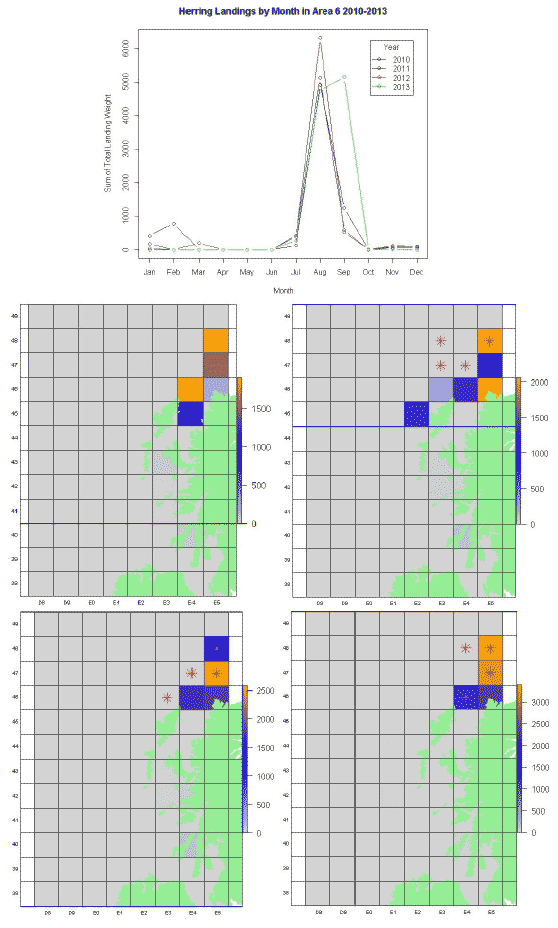Scottish Marine and Freshwater Science Volume 5 Number 15: Development of a Sampling Programme and Measurement of Contaminants in Food for Marine Strategy Framework Directive Descriptor 9
Descriptor 9 (contaminants in food) is one of eleven Marine Strategy Framework Directive (MSFD) qualitative Descriptors to be used in determining whether Good Environmental Status (GES) has been achieved for European regional seas (Directive EC/2008/56).
D9 sampling to the West of Scotland
Figure 9 shows the strata used in the 2013 Q4 and 2014 Q1 bottom trawl surveys on the West Coast. The stratification is based on fish densities from previous surveys (denoted by different colours) further stratified into contiguous areas (see labels on Q4 survey). There is no sampling in the white areas (unfishable) or in the west of the survey area, but this is not a problem as landings from these areas are negligible. There are several hauls in each stratum, the number depending on the area of the stratum and the variation in fish densities within it. For D9 monitoring, the landings in each stratum are estimated by assigning the reported landings from each ICES rectangle to the stratum with which it shares the greatest area; for example the landings from rectangle 40E2 are assigned to stratum G3 in the Q4 survey. The target numbers of fish in each stratum are then generated from the proportions of the total landings in each stratum (as before). In theory, the fish from each stratum should be randomly chosen from the hauls in that stratum. In practice, a sensible number of fish are retained from each haul (to ensure that the target number is met) and then the fish are randomly chosen from these.
Figure 9: Strata used for the 2013 Quarter 4 (left) and 2014 Quarter 1 (right) bottom trawls surveys of ICES Division VIa (black line). White areas are unfishable areas. No samples are taken in the west of the area (essentially beyond the 200 m contour) as this is not suitable habitat for the target species (cod, haddock, whiting, saithe and hake).

Haddock
The monthly pattern of West of Scotland haddock landings varied considerably over years ( Figure 10). The landings were relatively high and had the greatest consistency in Q1 and the Q1 survey is the obvious choice for D9 purposes. However, at the time of designing the survey (Oct 2013), only the 2012 and provisional 2013 landings had been considered and these suggested the Q4 survey was also a reasonable choice. Haddock landings are mostly from the north-east of the area ( Figure 10). A D9 sampling design was generated for the Q4 survey using provisional 2013 landings but, due to bad weather, only part of the survey area was covered, and only some of the required haddock were caught. A revised sampling design was, therefore, generated for the Q1 survey using revised 2013 landings ( Table 8). To avoid unnecessary sampling, those fish that had been caught on the Q4 survey were regarded as having come from the Q1 survey and used where possible.
D9 sampling design for West of Scotland haddock using the Q1 survey and 2013 landings. The last column gives the number of fish per haul required to provide a reasonable chance of sampling sufficient fish overall.
| Stratum | Landings (tonnes) | Sampling Probability | D9 sample size | Fish per haul |
|---|---|---|---|---|
| R1 | 155 | 0.04 | 2 | 1 |
| R2 | 61 | 0.02 | 0 | 0 |
| G1 | 2998 | 0.85 | 16 | 3 |
| B1 | 107 | 0.03 | 0 | 0 |
| LB | 156 | 0.04 | 1 | 1 |
| R3 | 45 | 0.01 | 1 | 1 |
Figure 10: Haddock landings (tonnes) by Scottish vessels into Scotland from ICES Division VIa 2010-13. Top: monthly landings. Bottom: spatial distribution (2010-2013 clockwise from top left).

Monkfish
The monthly pattern of West Coast monkfish landings was consistent over years ( Figure 11). Landings were relatively high throughout Q1 and usually high again in December. On this basis, the Q1 survey is a robust choice for D9 purposes. The spatial distribution of landings is consistent across years ( Figure 11) with landings mostly from close to the shelf edge (the 200 m controur). A D9 sampling design was generated for the Q1 survey using 2013 landings ( Table 9).
D9 sampling design for West of Scotland monkfish using the Q1 survey and 2013 landings. The last column gives the number of fish per haul required to provide a reasonable chance of sampling sufficient fish overall.
| Stratum | Landings (tonnes) | Sampling Probability | D9 sample size | Fish per haul |
|---|---|---|---|---|
| R1 | 226 | 0.25 | 4 | 3 |
| R2 | 168 | 0.19 | 3 | 3 |
| G1 | 414 | 0.46 | 11 | 2 |
| LB | 56 | 0.06 | 2 | 2 |
Figure 11 Monkfish landings (tonnes) by Scottish vessels into Scotland from ICES Division VIa 2010-13. Top: monthly landings. Bottom: spatial distribution (2010-2013 clockwise from top left).

Herring
Herring landings usually peak in August, with virtually all landings between July and September ( Figure 12). As the herring acoustic survey ( HERAS) is the only survey of the West of Scotland area in Quarter 3, this survey was used to collect herring samples for D9 purposes. Across years, herring landings have been consistently high in the north east of the area and low elsewhere ( Figure 12). HERAS has a predetermined route, which includes the part of the West of Scotland area with high herring landings. However, HERAS only trawls for fish to ground-truth acoustic readings. During the last three HERAS surveys, at least four statistical rectangles were trawled ( Figure 12). These rectangles varied between years, but the rectangle with the highest landings in 2013 was trawled every year and nearby rectangles were also trawled. Since trawling locations are unknown before the survey, a D9 design based on landings could not be generated. Instead, given that every year at least four statistical squares are trawled, five fish will be required from each trawled rectangle to meet the minimum requirement of 20 fish. This was doubled to ten fish from each trawled rectangle for contingency. The choice of fish for analysis will then be based on a post-hoc randomisation of the sampled fish based on the herring landings in 2014.
Figure 12: Herring landings (tonnes) by Scottish vessels into Scotland from ICES Division VIa 2010-13. Top: monthly landings. Bottom: spatial distribution (2010-2013 clockwise from top left). Red stars indicated herring acoustic survey ( HERAS) locations (only data from 2011-2013 used).

Contact
There is a problem
Thanks for your feedback